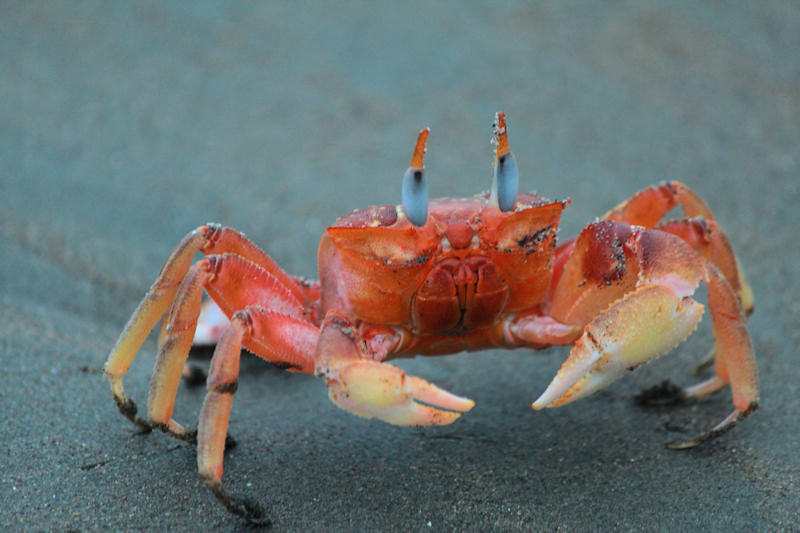Ghosts on the Beach!
Hey everyone! Sorry for the delay, Halloween and other events just made the week go by so fast. So I owe you two posts this week for our Halloween spooky critters series. Out on the beach I visit, there are some creepy critters, perfect for Halloween, called ghost crabs! How perfect of a name to induce the shivers!

Atlantic Ghost Crab. Picture from https://commons.wikimedia.org/wiki/File:Ghost_Crab_at_Smyrna_Dunes_Park_-_Flickr_-_Andrea_Westmoreland.jpg
Ghost crabs are neat “little” crabs that make holes in the beach. The name “ghost” crab refers to their nocturnal habits (coming out at night) and their ability to blend in with the sand, making them hard to see. Sometimes, they are called sand crabs, but so are many other species of crabs, so watch out for common names.

Atlantic Ghost Crab. Picture from http://www.nps.gov
Their holes can be up to four feet deep! They have the typical structure of crabs, 10 legs (8 walking legs and two pincers). They have two different sizes of claws, but unlike fiddler crabs, both males and females have mismatched claws. Their eyes stick up on stalks. Their stalk eyes allow them to see 360 degrees around, but not straight above them. They breathe through gills, so their burrows must reach down to the moist sand. They cannot stay submerged in water for very long, or they will drown (weird!); they just need to keep their gills moist with the sea water, and then they breathe air. Their food consists of scavenged dead animals, plant material, clams, sea turtle hatchlings, and even other crabs.
Atlantic Ghost Crab. Picture from http://travellogs.us/Miscellaneous/Ghost%20Crab/Ghost%20Crab.htm
They are quick moving critters, with a top speed of 10 mph! Ghost crabs are one of the fastest crustaceans. From my experience, they rarely sustained those speeds for very long. They either freeze in a place where they think they are hidden of protected, or they make it to their burrow. They can move sideways, forwards, and backwards.
Ghost Crabs are found easily at night during the summer, using flashlights. Although they are not swimmers, they are often near the edge of the ocean for food and protection from predators. Predators include raccoons, gulls, and burrowing owls. Ghost Crabs will hibernate in the winter. Sitting way down in their burrow, in a chamber at the bottom of the tunnel. They will periodically emerge if they need to re-wet their gills, or get food.

Predator of Ghost Crab. Picture from http://www.blogthebeach.com/2012/nature/birds/yellow-crowned-night-heron-stalking-and-eating-a-ghost-crab
Although they are not swimmers as adults, ghost crabs begin life in the water. The female must make sure the eggs stay wet when she is carrying them. They then become amphibious before becoming completely land-dwelling. Unlike other crab species, ghost crabs can mate anytime during the year after sexual maturity has been reached. (Other crab species usually have to wait until the female’s shell is soft).
There are 22 different species of ghost crabs, but there is only one species of ghost crab found along the Atlantic coast of the United States, the Atlantic Ghost Crab. The Atlantic Ghost Crab (not sure about other species) can produce 3 different sounds: a rapping of the claw on the sand, a rasping stridulation of the legs, and a bubbling sound.

Horned Ghost Crab. Picture from “Ocypode-ceratophthalma-horned-ghost-crab-krabi-thailand” by Rushenb – Own work. Licensed under CC BY-SA 3.0 via Commons – https://commons.wikimedia.org/wiki/File:Ocypode-ceratophthalma-horned-ghost-crab-krabi-thailand.jpg#/media/File:Ocypode-ceratophthalma-horned-ghost-crab-krabi-thailand.jpg

Painted Ghost Crab. Picture from “Ghost crab – Ocypode gaudichaudii” by Hanumann – Ghost crab. Licensed under CC BY 2.0 via Commons – https://commons.wikimedia.org/wiki/File:Ghost_crab_-_Ocypode_gaudichaudii.jpg#/media/File:Ghost_crab_-_Ocypode_gaudichaudii.jpg
Depending on where they are located, ghost crabs can be dark or light in color. They can actually change their coloration to match the surrounding area. This occurs slowly, over a longer period of time instead of quickly like a chameleon.

Horned Ghost Crab. Picture from “Starr 031007-2031 Ocypode ceratophthalmus” by Forest & Kim Starr. Licensed under CC BY 3.0 via Commons – https://commons.wikimedia.org/wiki/File:Starr_031007-2031_Ocypode_ceratophthalmus.jpg#/media/File:Starr_031007-2031_Ocypode_ceratophthalmus.jpg

Horned Ghost Crab. Picture from “Ocypode ceratophthalma (Kauai, Hawaii)” by Robert from Ashburn, United States – Black Sand Crab. Licensed under CC BY-SA 2.0 via Commons – https://commons.wikimedia.org/wiki/File:Ocypode_ceratophthalma_(Kauai,_Hawaii).jpg#/media/File:Ocypode_ceratophthalma_(Kauai,_Hawaii).jpg
These crabs are lots of fun to catch and release, but I highly recommend using a net and a bucket instead of your hands (at least with the large ones)! Their pinches can hurt (personal experience)! It’s a great activity for any age. Keep your eyes open while you enjoy exploring the beaches for these mysterious “ghosts.”
Remember,
The more knowledge you have, the less scary the world becomes.
Keep going outside and gaining more knowledge!